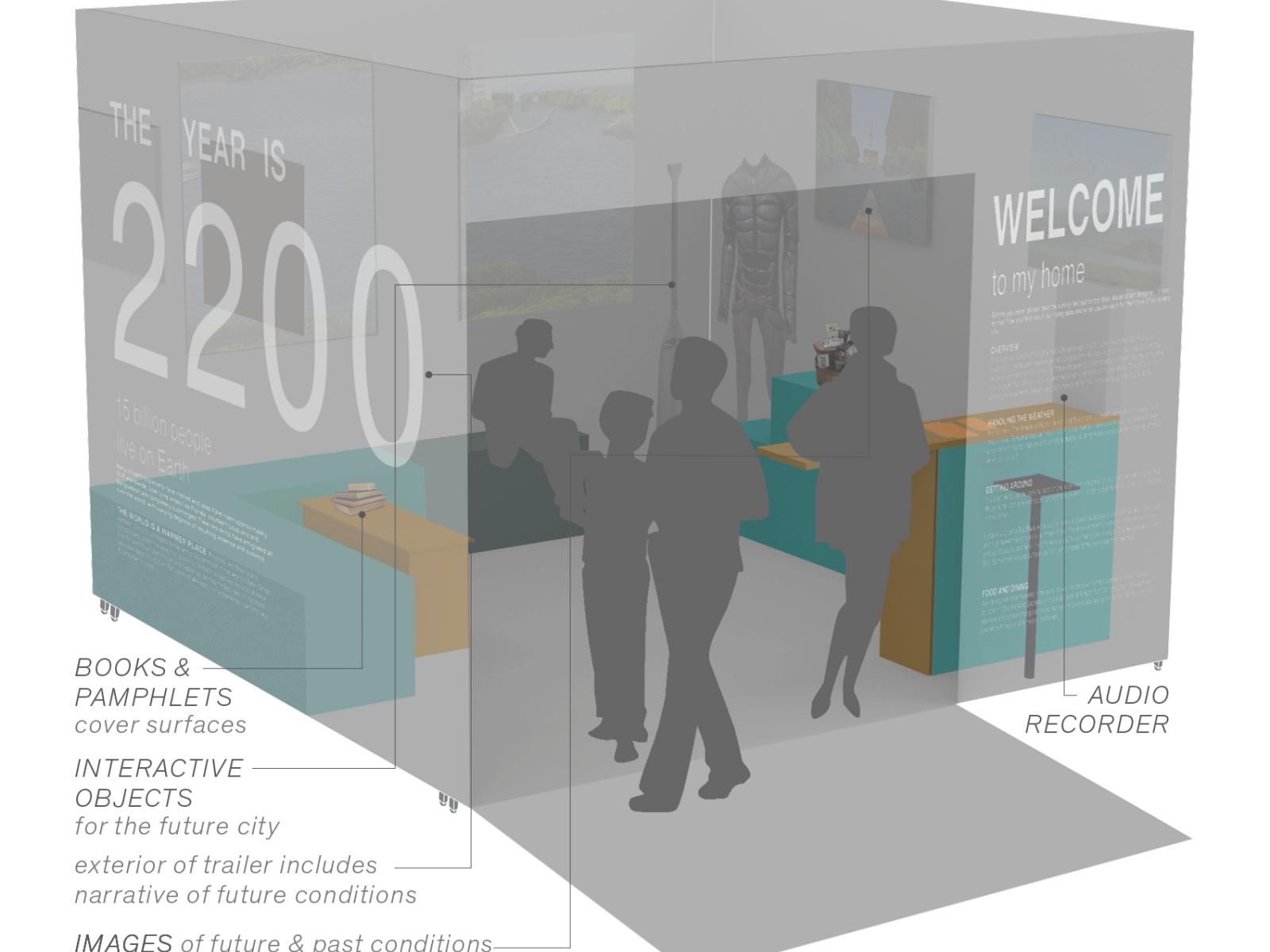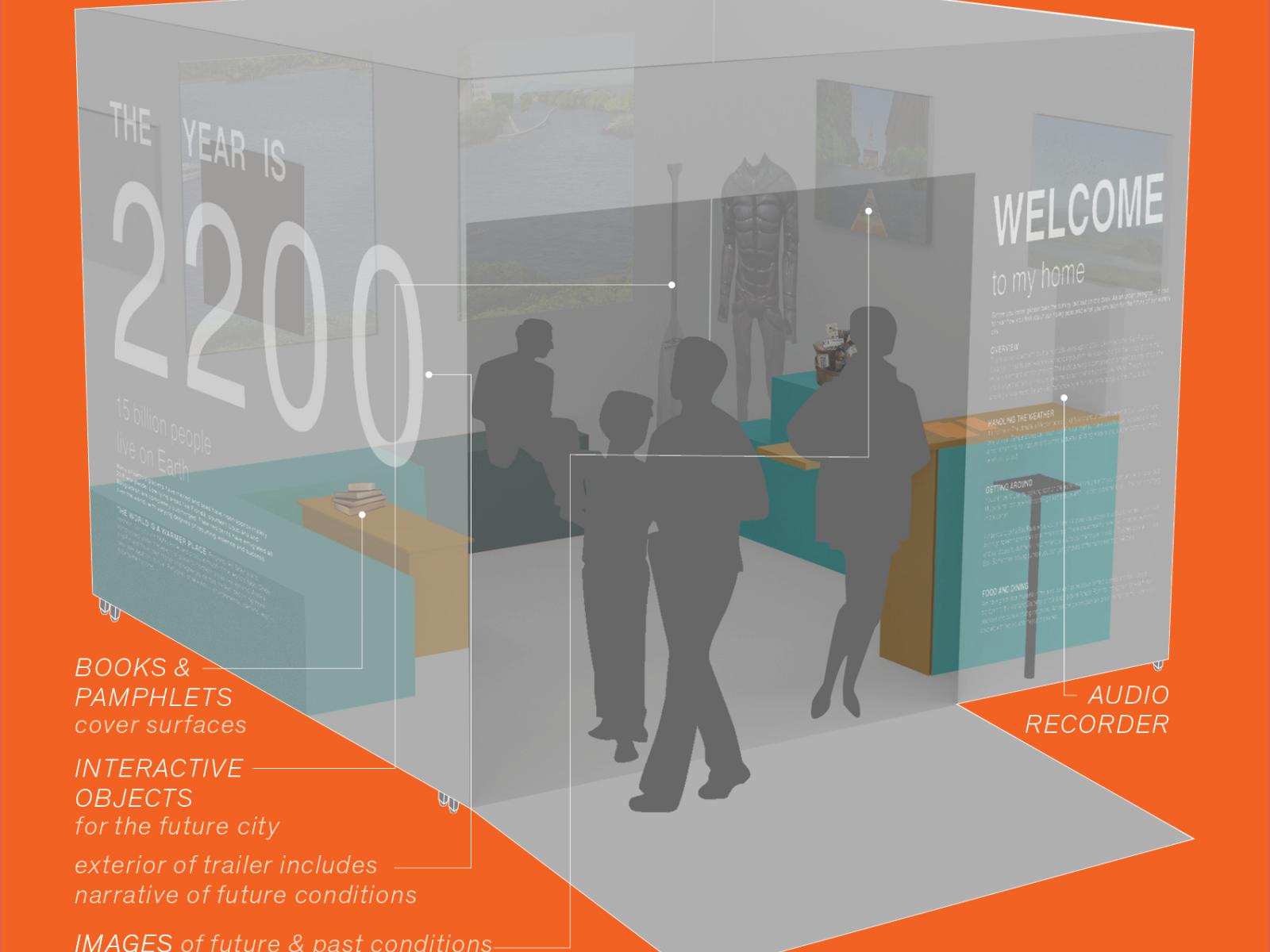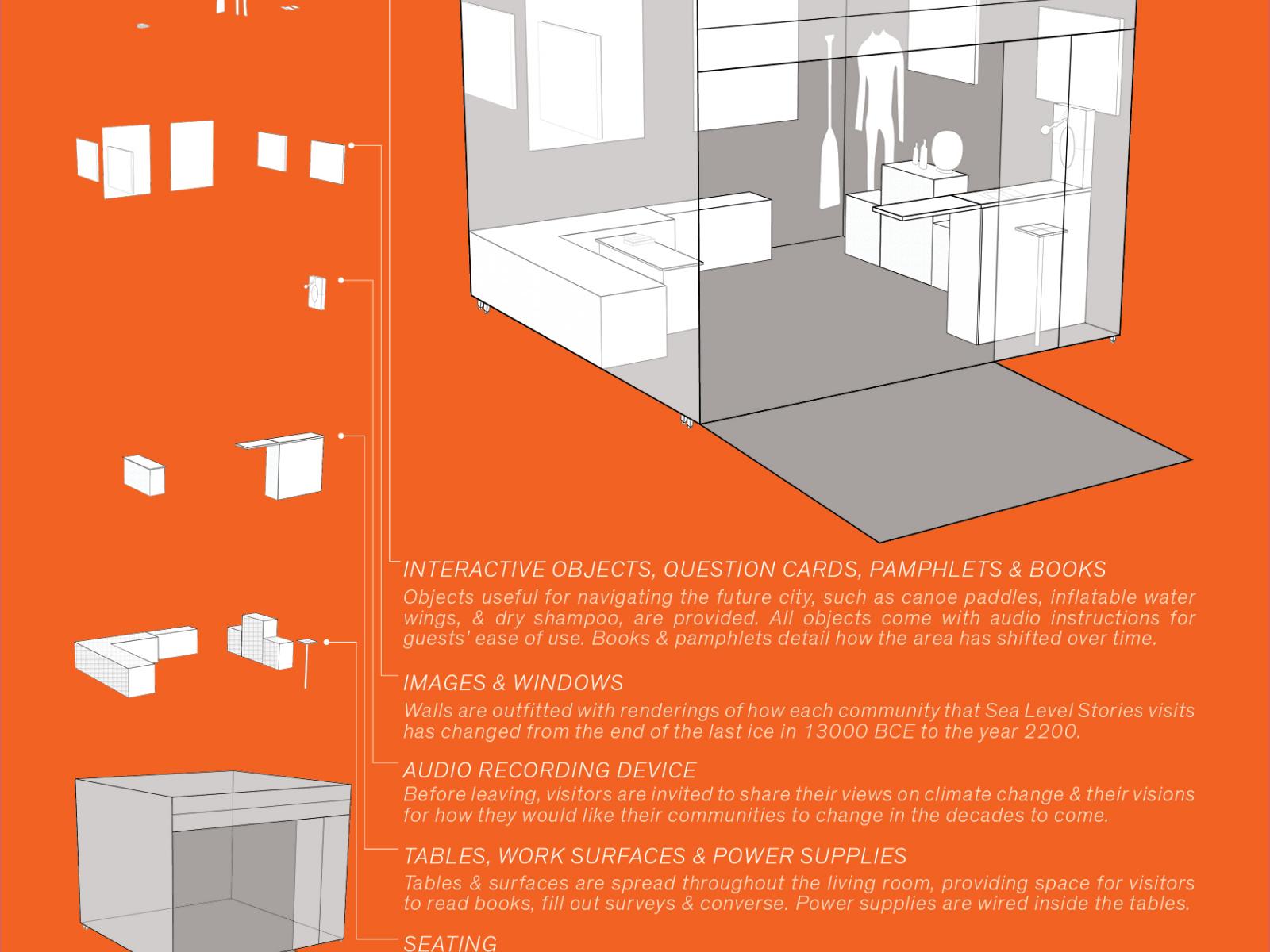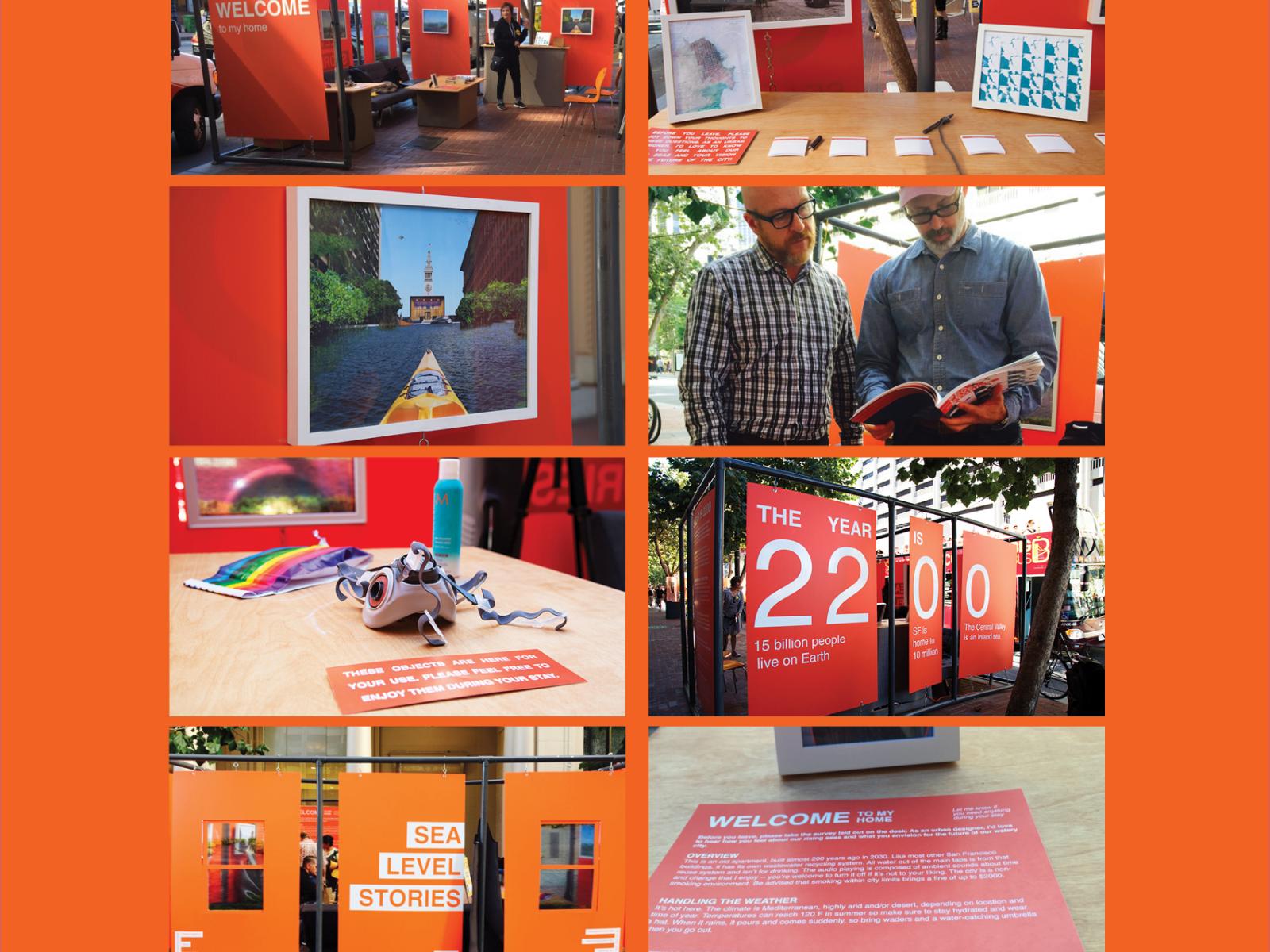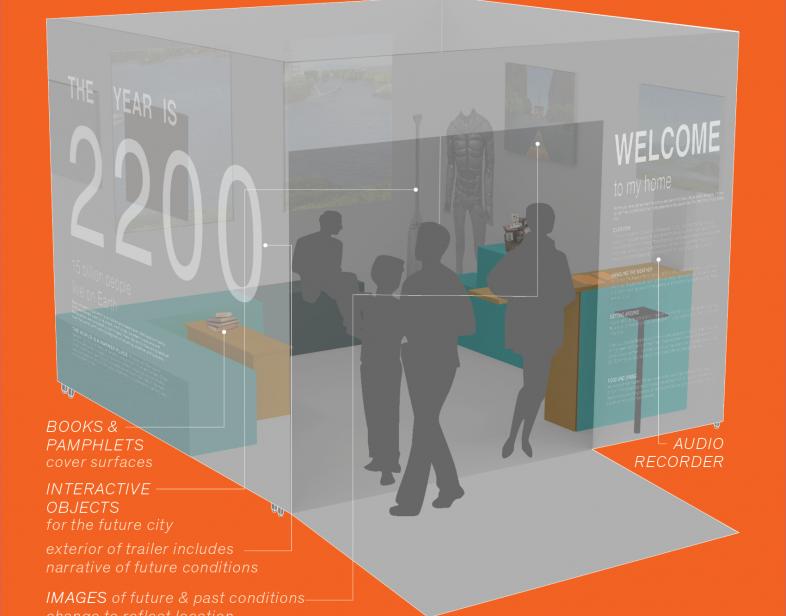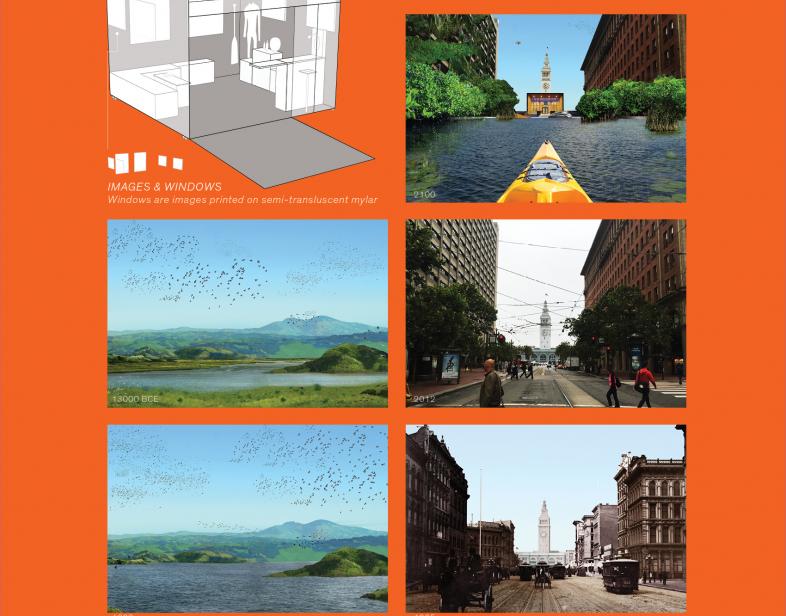An Overview Of Our Solution
Addressing climate change is hard to do. With such wide-ranging impacts, it’s nearly impossible to visualize, encouraging many to view the issue through pre-existing beliefs & prejudices. Research shows that deeper understanding of climate impacts provides the motivation we need to tackle these obstacles.
A mobile, interactive community hub that cultivates grassroots support for climate adaptation planning, Climate Stories is designed to address these issues. The format is a trailer retrofitted as a living room from the year 2200. By walking inside, visitors land in the world as it could be 200 years from now. Embedded with community planning tools, the project is a space for processing concerns about our changing climate & creating more grassroots engagement in how we plan for our future.
- Population Impacted: 10,000+
- Continent: North America
Context Analysis
Spreading climate change awareness remains one of our greatest collective challenges. Recent polls show that while more than 50% of Americans believe that climate change will “harm people in the United States,” fewer than 40% believe it will “harm me, personally.” That lack of physical connection to the issues encourages many people to respond with pre-existing beliefs & prejudices.
Deeper understanding of climate impacts provides the motivation we need to tackle these obstacles. To cultivate more inclusive climate action, we have to reach people on more emotional levels. We have to broaden the tools we use to talk about change.
In order to create more broad-based action, we need publicly accessible learning opportunities imbued with fun, whimsy & emotion. Climate Stories gives visitors an articulated future they can enter. This kind of immersion into what our future could be helps people relate to the realities of climate change on more immediate levels.
Describe the technical solution you wanted the target audience to adopt
While at Climate Stories, visitors can share reflections on climate change & listen to those left by others. They’re also invited to answer questions on their feelings about shifting climates & visions of the ideal city. People can record responses via audio, paper or drawings. Answers feed into Climate Stories' database on public perceptions of climate change across different communities.
All are invited to take immediate climate actions, like donating to mitigation movements, shifting savings to more responsible banking systems & connecting to local planning organizations. Everyone is connected to the Climate Stories network to receive updates on climate adaptation news & opportunities.
Climate Stories gathers valuable information on public reflections on climate change, providing insight on the words that different communities use to talk about change. Their answers, comments & questions are critical for cultivating more approachable dialogues about our collective futures.
Type of intervention
Describe your behavioral intervention
As participants use the Climate Stories tool, answering questions and sharing their reflections, they help to grow our database on public perceptions and concerns on climate change issues. This database helps inform local and regional adaptation and mitigation planning efforts. Responses and answered questions collected from Climate Stories is made available to regional planning agencies, providing a wealth of valuable information on citizen views on climate change and adaptive strategies. Planned interventions benefit from regular public feedback, ensuring that funding is wisely spent on projects that will benefit those they’re intended to serve. Collected data likewise helps planners, designers and climate communicators understand more about local communities’ attitudes, preferences, fears and language used to talk about change. This information provides critical tools to refine communication methods for spreading adaptation information, setting the scene for greater mobilization and broad based public support for adaptation efforts.
By locating these learning-based, data-collection experiences within existing community events, Climate Stories becomes an engaging, publicly accessible way to inform people about climate change impacts, as well as a tool through which users can express their concerns and ideas, and develop actionable strategies for adaptation.
As needed, please explain the type of intervention in more detail
By walking into Climate Stories, visitors land 200 years in the future, when sea levels have risen 25 ft & the world is a warmer place. They land in the living room of an urban designer who is renting them the use of her apartment, which comes with objects useful for navigating the future. All objects come with interactive audio instructions.
Walls are decorated with screens showing images & maps of how the region in which Climate Stories is installed has changed from centuries past to the “present” (the year 2200). Books & pamphlets detailing changes on the site are provided. Images, maps, books & pamphlets of changing conditions are researched & designed for each site, so that depicted scenarios are connected to individual communities.
Describe your implementation
By contextualizing climate change as an ongoing fact of life, the project presents an opportunity to cultivate a different kind of dialogue about climate change, one that’s more about embracing change than fearing the unknown. Presenting the process of climatic shifts and rising tides at a range of scales -- from street-level images to regional maps and more -- is a way to help people relate to this large-scale phenomena on a more personal level. Allowing people to share their impressions after seeing these visualizations provides a place for meditation on the issue and generates a valuable wealth of data on public perception of sea level rise. Both are vitally important.
Working with community partnerships identified and developed ahead of time, Climate Stories is deployed in a new site. Where appropriate, its presence is integrated into existing community programs, such as classes in local schools and farmers markets. On-site work involves engaging with visitors about local and regional adaptation planning efforts, and recording visitor responses, in order to grow the Climate Stories database on public perceptions of climate change to better inform climate outreach and engagement efforts across the country. Answers to these questions feed into Climate Stories’ growing database on public perceptions of climate change and adaptation priorities across different communities.
Before leaving, participants are invited to take immediate climate actions, from donating to existing adaptation and mitigation movements, tips and instructions on shifting savings to more responsible banking and investments systems, and/or connecting to local planning organizations and individuals to continue the Climate Stories experience after they leave. Everyone is connected to the Climate Stories network, where they can receive updates on climate adaptation news and initiatives, and receive weekly newsletters on actions they can take in their own communities.
External connections
Climate Stories is designed to be deployed and installed in conjunction with community sponsored partnerships and local government support. Our organization, Shiftworks, and organization dedicated to building climate action through storytelling and design, develops the Climate Stories platform in conjunction with a suite of volunteers and partners at Stanford’s Woods Institute for the Environment and San Francisco’s Market Street Prototyping Festival.
Shiftworks are run and staffed by design professionals, with years of experience developing and building dynamic projects, from high-rise buildings to interactive furniture. We additionally provide research and visualization services to illustrate effects of climate change in each site where Climate Stories is installed. We collaborate with local communities and municipal organizations in installation sites to develop greater understanding of research previously conducted and any relevant community planning precedents to take into consideration.
Other essential actors are Climate Stories users – the diverse peoples who comprise the communities of the cities and regions where Climate Stories is deployed and who will use the storytelling interface, join the Climate Stories network and engage in climate action.
Who adopted the desired behaviors and to what degree?
Climate Stories cultivates more inclusive climate planning across the US. We are the 2nd biggest emitter of greenhouse gas yet remain resistant to coordinated change action. While much of our population currently accepts climate change as real, there are still many who do not agree or feel excluded from many of the adaptive planning processes taking place.
Climate Stories is designed to bridge those divides. Doing so sets the stage for more community-based, empowered & collaborative adaptation planning efforts, at both the local & regional levels. Engaged communities will be primarily those of color & lower socio-economic status.
We will work with state and national-reaching networks for design & policy professionals & volunteers. Outreach for each installation will be conducted through environmental advocacy groups, local schools, religious organizations & social media, with calendar ads and listings through local publications & radio stations.
How did you impact natural resource use and greenhouse gas emissions?
Recent polls show that while more than 50% of Americans believe that climate change will “harm people in the United States,” fewer than 40% believe it will “harm me, personally.” That lack of physical connection to the issues is the chasm Climate Stories works to bridge.
Installed in publicly accessible sites across the country, Climate Stories connects people from diverse communities to greater national climate change conversations & direct actions. From learning about ways that they can mitigate emissions in their own communities to connecting with national adaptation movements through donations &membership opportunities, visitors are connected to climate change action. By bringing the climate conversation right to people’s communities, Climate Stories makes climate action fun, engaging & accessible. This sets the stage for more community-based, empowered & collaborative adaptation planning efforts, at the local, regional & national levels.
What were some of the resulting co-benefits?
More & more these days, negotiating climate change is a storytelling issue. Even for those who accept that the science of climate change is real, how exactly to adapt – what policies to enact, which time frames to focus on – remains a conundrum. Start planning for the future and short-term interests quickly contrast with long-term uncertainties, paving the way to confusion.
In order to harness the long-term thinking needed in climate planning, we have to use storytelling to work with our short-term brain. When we find ways to connect to events and impacts that we have yet to personally experience, our levels of empathy and engagement grow, helping us think beyond the envelope of our own lives, and take the longer view.
Climate Stories uses storytelling to activate the short-term brain in service of long-term thinking. Climate change is arguably both the hardest issue to grasp & the most important one to understand. Strong storytelling, as used in Climate Stories, is our way to get there.
Sustainability
This project relies on grant funding and government subsidies for its initial launch.
Return on investment
Costs to bring Climate Stories to its first 7 sites (Houston, TX; Salt Lake City, UT; Tallahassee FL; Charlotte, SC; Macon, Georgia; Rolla, MO Bozeman, MA) are $58,220. Costs for the 1st installation are $21,320. Each subsequent installation is $6,150.
The retrofitted Climate Stories trailer costs $15,170. Interactive objects have already been fabricated & are not included in the cost. Costs for images, pamphlets & books are $1750 for each site. Each 1-week installation costs $3000 for time, travel, lodging, food & community engagement work for Climate Stories operators. Before installation, each location requires 40 hours of planning, permitting & programming work, totaling $1400 for each site visited.
How could we successfully replicate this solution elsewhere?
To encourage greater use of the Climate Stories tool across more geographies, we will develop a Climate Stories toolkit. Once initial targets with the United States (our starting focus country) have been addressed, we will create open source resources where communities from different locations can download the tools to create their own Climate Stories center, to engage their own neighbors and constituents in proactive, multi-sensory climate action.
Open source, download-able resources will enable communities from different regions & countries to create their own Climate Stories center. Funds needed to develop the toolkit are $10,000.
